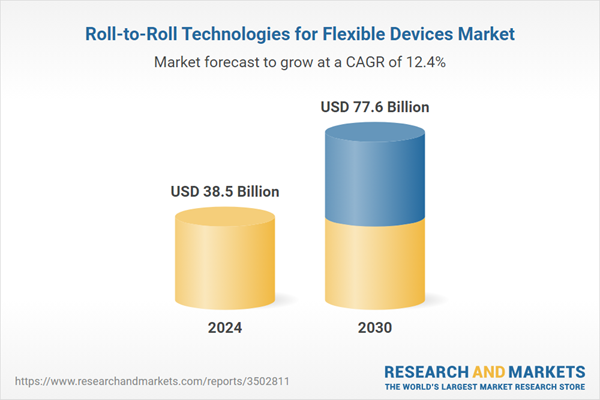The global market for Roll-to-Roll Technologies for Flexible Devices was valued at US$38.5 Billion in 2024 and is projected to reach US$77.6 Billion by 2030, growing at a CAGR of 12.4% from 2024 to 2030. This comprehensive report provides an in-depth analysis of market trends, drivers, and forecasts, helping you make informed business decisions. The report includes the most recent global tariff developments and how they impact the Roll-to-Roll Technologies for Flexible Devices market.
The development and application of R2R technologies have been driven by significant advancements in materials science and printing techniques. Innovations in conductive inks, organic semiconductors, and flexible substrates have played a crucial role in the viability of R2R processes. Conductive inks made from materials like silver nanowires, carbon nanotubes, and conductive polymers allow for efficient electrical conductivity on flexible substrates. Organic semiconductors, which are essential for the production of flexible transistors and photovoltaic cells, offer advantages in terms of mechanical flexibility and low-temperature processing. Additionally, advancements in printing techniques such as gravure, flexographic, and screen printing have improved the precision and resolution of electronic patterns on flexible materials. These technological breakthroughs have expanded the potential applications of R2R technologies, making them integral to the development of next-generation flexible electronic devices.
The growth in the roll-to-roll technologies for flexible devices market is driven by several factors, including increasing demand for wearable electronics, advancements in material science, and the push for sustainable manufacturing processes. The rising popularity of wearable devices, such as fitness trackers, smartwatches, and medical monitoring devices, has created a substantial demand for flexible electronics that can conform to the human body. Advancements in material science, particularly in the development of flexible, lightweight, and conductive materials, have enhanced the performance and reliability of R2R-printed electronics. Furthermore, the growing emphasis on sustainable and cost-effective manufacturing processes has propelled the adoption of R2R technologies. These processes reduce material waste and energy consumption compared to traditional fabrication methods, aligning with the increasing environmental regulations and consumer demand for greener products. Additionally, the integration of R2R technologies with other advanced manufacturing techniques, such as additive manufacturing and 3D printing, is opening new avenues for innovation and market growth. These factors collectively underscore the dynamic expansion of the R2R technologies for flexible devices market, highlighting its crucial role in shaping the future of electronic manufacturing.
Segments: Application (Consumer Electronics, Automotive, Energy, Healthcare, Aerospace & Defense, and Other Applications).
Geographic Regions/Countries: World; USA; Canada; Japan; China; Europe; France; Germany; Italy; UK; Spain; Russia; Rest of Europe; Asia-Pacific; Australia; India; South Korea; Rest of Asia-Pacific; Latin America; Argentina; Brazil; Mexico; Rest of Latin America; Middle East; Iran; Israel; Saudi Arabia; UAE; Rest of Middle East; Africa.
The analysts continuously track trade developments worldwide, drawing insights from leading global economists and over 200 industry and policy institutions, including think tanks, trade organizations, and national economic advisory bodies. This intelligence is integrated into forecasting models to provide timely, data-driven analysis of emerging risks and opportunities.
Global Roll-to-Roll Technologies for Flexible Devices Market - Key Trends & Drivers Summarized
Roll-to-roll (R2R) technologies for flexible devices represent a transformative approach in the manufacturing of electronics, offering significant advantages in terms of cost, efficiency, and scalability. This process involves continuous rolling substrates, such as flexible plastic or metal foils, onto which electronic components are printed or coated using various techniques like inkjet printing, gravure printing, or vacuum deposition. The ability to fabricate electronics on a flexible substrate allows for the production of lightweight, bendable, and durable devices, which are ideal for a wide range of applications including flexible displays, wearable sensors, photovoltaic cells, and flexible batteries. R2R manufacturing not only enhances production speed and reduces material waste but also enables the creation of large-area electronics that are difficult to achieve with traditional fabrication methods.The development and application of R2R technologies have been driven by significant advancements in materials science and printing techniques. Innovations in conductive inks, organic semiconductors, and flexible substrates have played a crucial role in the viability of R2R processes. Conductive inks made from materials like silver nanowires, carbon nanotubes, and conductive polymers allow for efficient electrical conductivity on flexible substrates. Organic semiconductors, which are essential for the production of flexible transistors and photovoltaic cells, offer advantages in terms of mechanical flexibility and low-temperature processing. Additionally, advancements in printing techniques such as gravure, flexographic, and screen printing have improved the precision and resolution of electronic patterns on flexible materials. These technological breakthroughs have expanded the potential applications of R2R technologies, making them integral to the development of next-generation flexible electronic devices.
The growth in the roll-to-roll technologies for flexible devices market is driven by several factors, including increasing demand for wearable electronics, advancements in material science, and the push for sustainable manufacturing processes. The rising popularity of wearable devices, such as fitness trackers, smartwatches, and medical monitoring devices, has created a substantial demand for flexible electronics that can conform to the human body. Advancements in material science, particularly in the development of flexible, lightweight, and conductive materials, have enhanced the performance and reliability of R2R-printed electronics. Furthermore, the growing emphasis on sustainable and cost-effective manufacturing processes has propelled the adoption of R2R technologies. These processes reduce material waste and energy consumption compared to traditional fabrication methods, aligning with the increasing environmental regulations and consumer demand for greener products. Additionally, the integration of R2R technologies with other advanced manufacturing techniques, such as additive manufacturing and 3D printing, is opening new avenues for innovation and market growth. These factors collectively underscore the dynamic expansion of the R2R technologies for flexible devices market, highlighting its crucial role in shaping the future of electronic manufacturing.
Report Scope
The report analyzes the Roll-to-Roll Technologies for Flexible Devices market, presented in terms of units. The analysis covers the key segments and geographic regions outlined below.Segments: Application (Consumer Electronics, Automotive, Energy, Healthcare, Aerospace & Defense, and Other Applications).
Geographic Regions/Countries: World; USA; Canada; Japan; China; Europe; France; Germany; Italy; UK; Spain; Russia; Rest of Europe; Asia-Pacific; Australia; India; South Korea; Rest of Asia-Pacific; Latin America; Argentina; Brazil; Mexico; Rest of Latin America; Middle East; Iran; Israel; Saudi Arabia; UAE; Rest of Middle East; Africa.
Key Insights:
- Market Growth: Understand the significant growth trajectory of the Consumer Electronics segment, which is expected to reach US$44.6 Billion by 2030 with a CAGR of a 11.9%. The Automotive segment is also set to grow at 13.0% CAGR over the analysis period.
- Regional Analysis: Gain insights into the U.S. market, valued at $6.3 Billion in 2024, and China, forecasted to grow at an impressive 13.9% CAGR to reach $31.0 Billion by 2030. Discover growth trends in other key regions, including Japan, Canada, Germany, and the Asia-Pacific.
Why You Should Buy This Report:
- Detailed Market Analysis: Access a thorough analysis of the Global Roll-to-Roll Technologies for Flexible Devices Market, covering all major geographic regions and market segments.
- Competitive Insights: Get an overview of the competitive landscape, including the market presence of major players across different geographies.
- Future Trends and Drivers: Understand the key trends and drivers shaping the future of the Global Roll-to-Roll Technologies for Flexible Devices Market.
- Actionable Insights: Benefit from actionable insights that can help you identify new revenue opportunities and make strategic business decisions.
Key Questions Answered:
- How is the Global Roll-to-Roll Technologies for Flexible Devices Market expected to evolve by 2030?
- What are the main drivers and restraints affecting the market?
- Which market segments will grow the most over the forecast period?
- How will market shares for different regions and segments change by 2030?
- Who are the leading players in the market, and what are their prospects?
Report Features:
- Comprehensive Market Data: Independent analysis of annual sales and market forecasts in US$ Million from 2024 to 2030.
- In-Depth Regional Analysis: Detailed insights into key markets, including the U.S., China, Japan, Canada, Europe, Asia-Pacific, Latin America, Middle East, and Africa.
- Company Profiles: Coverage of players such as DuPont de Nemours, Inc., Asahi Kasei Corporation, Eastman Kodak Company, Applied Materials, Inc., Agfa-Gevaert NV and more.
- Complimentary Updates: Receive free report updates for one year to keep you informed of the latest market developments.
Some of the 68 companies featured in this Roll-to-Roll Technologies for Flexible Devices market report include:
- DuPont de Nemours, Inc.
- Asahi Kasei Corporation
- Eastman Kodak Company
- Applied Materials, Inc.
- Agfa-Gevaert NV
- imec international
- AU Optronics Corporation
- Industrial Technology Research Institute
- Flexium Interconnect, Inc.
- Hanergy Holding Group Ltd.
- Isovolta AG
- Ascent Solar Technologies, Inc.
- Canatu Oy
- GSI Technologies LLC
- Enfucell Oy
Tariff Impact Analysis: Key Insights for 2025
Global tariff negotiations across 180+ countries are reshaping supply chains, costs, and competitiveness. This report reflects the latest developments as of April 2025 and incorporates forward-looking insights into the market outlook.The analysts continuously track trade developments worldwide, drawing insights from leading global economists and over 200 industry and policy institutions, including think tanks, trade organizations, and national economic advisory bodies. This intelligence is integrated into forecasting models to provide timely, data-driven analysis of emerging risks and opportunities.
What’s Included in This Edition:
- Tariff-adjusted market forecasts by region and segment
- Analysis of cost and supply chain implications by sourcing and trade exposure
- Strategic insights into geographic shifts
Buyers receive a free July 2025 update with:
- Finalized tariff impacts and new trade agreement effects
- Updated projections reflecting global sourcing and cost shifts
- Expanded country-specific coverage across the industry
Table of Contents
I. METHODOLOGYII. EXECUTIVE SUMMARY2. FOCUS ON SELECT PLAYERSIII. MARKET ANALYSISIV. COMPETITION
1. MARKET OVERVIEW
3. MARKET TRENDS & DRIVERS
4. GLOBAL MARKET PERSPECTIVE
UNITED STATES
CANADA
JAPAN
CHINA
EUROPE
FRANCE
GERMANY
ITALY
UNITED KINGDOM
SPAIN
RUSSIA
REST OF EUROPE
ASIA-PACIFIC
SOUTH KOREA
TAIWAN
REST OF ASIA-PACIFIC
LATIN AMERICA
REST OF WORLD
Companies Mentioned (Partial List)
A selection of companies mentioned in this report includes, but is not limited to:
- DuPont de Nemours, Inc.
- Asahi Kasei Corporation
- Eastman Kodak Company
- Applied Materials, Inc.
- Agfa-Gevaert NV
- imec international
- AU Optronics Corporation
- Industrial Technology Research Institute
- Flexium Interconnect, Inc.
- Hanergy Holding Group Ltd.
- Isovolta AG
- Ascent Solar Technologies, Inc.
- Canatu Oy
- GSI Technologies LLC
- Enfucell Oy
Table Information
| Report Attribute | Details |
|---|---|
| No. of Pages | 321 |
| Published | April 2025 |
| Forecast Period | 2024 - 2030 |
| Estimated Market Value ( USD | $ 38.5 Billion |
| Forecasted Market Value ( USD | $ 77.6 Billion |
| Compound Annual Growth Rate | 12.4% |
| Regions Covered | Global |









